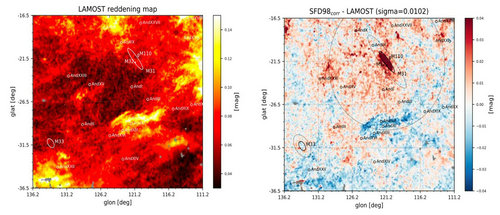LAMOST Helps Detect Dust in the Outskirts of Andromeda Galaxy and Triangulum Galaxy
Dust as an annoying thing is quite common in our everyday lives. But the ubiquitous dust in the vast universe is a subject of great interest to astronomers.
A recent work led by Doctoral Candidate ZHANG Ruoyi and Prof. YUAN Haibo from the Department of Astronomy, Beijing Normal University, reports the detection of dust in the outskirts of Andromeda Galaxy (M31) and Triangulum Galaxy (M33).
The results were published in The Astrophysical Journal Letters.
M 31 and M 33 are the largest and 3rd largest galaxies in the Local Group, respectively. It is extremely challenging to detect dust in the outskirts of M 31 and M 33, as their signals are very weak, in terms of either dust absorption in optical and/or emission in far infrared, compared to those of dust in the Milky Way. Therefore, the signals from Galactic foreground dust have to be removed carefully.
Fortunately, thanks to the Large Sky Area Multi-Object Fiber Spectroscopic Telescope (LAMOST, also known as Guoshoujing Telescope), operated by National Astronomical Observatories of Chinese Academy of Sciences (NAOC), millions of high-quality spectra have been recorded, providing a great opportunity to map the dust distribution in the Milky Way.
Using a sample of about 190,000 stars from the LAMOST and Gaia, the researchers constructed a large and precise two-dimensional foreground dust reddening map toward the M31 and M33 region.
"This foreground dust reddening map tells people how much light is absorbed by dust in the Milky Way," said ZHANG Ruoyi, the leading author of this study. The map shows the complex structure of dust clouds toward the M31, suggesting that the map should be used for precise foreground reddening corrections for targets in M 31.
By carefully removing the foreground reddening from the SFD98 dust reddening map, which contains dust signals from all the Milky Way, M31 and M33, the distribution of dust in the outskirts of M31 and M33 are revealed in great detail to a very large distance. Dust in the M31 and M33 disks extends out to about 2.5 times their optical radii.
The researchers also found that a significant amount of dust in clumpy and filamentary structures exists in the halo of M31, out to a distance of over 100 kiloparsec (1 kiloparsec equals to 3260 light years), which is about 5 times its optical radius.
Where do the dust clouds in the halo come from? Are their properties similar to those in the disk? There are interesting questions to be answered. "Our results combined with future observations, e.g., observations by FAST, will provide new clues on the distributions, properties, and cycling of dust in spiral galaxies," said Prof. YUAN Haibo, the corresponding author.

Figure: Left: Foreground reddening map of LAMOST. The solid ellipses mark the optical extent of M31, M33, and two satellites M32 and M101. Right: Dust reddening map of M 31 and M 33. The two dotted ellipses centered on M31 and M33 represent the extent of their dust disks. The large circle centered on M31 represents the extent of its dust halo. (Credit: Ruoyi Zhang)
The paper can be accessed at https://iopscience.iop.org/article/10.3847/2041-8213/abccc4.
Media Contact: Prof. XU Ang, annxu@nao.cas.cn